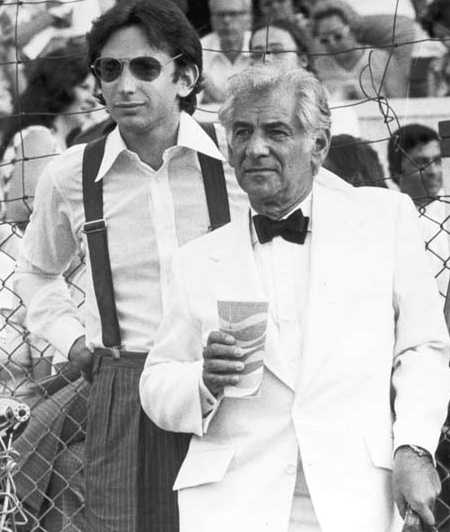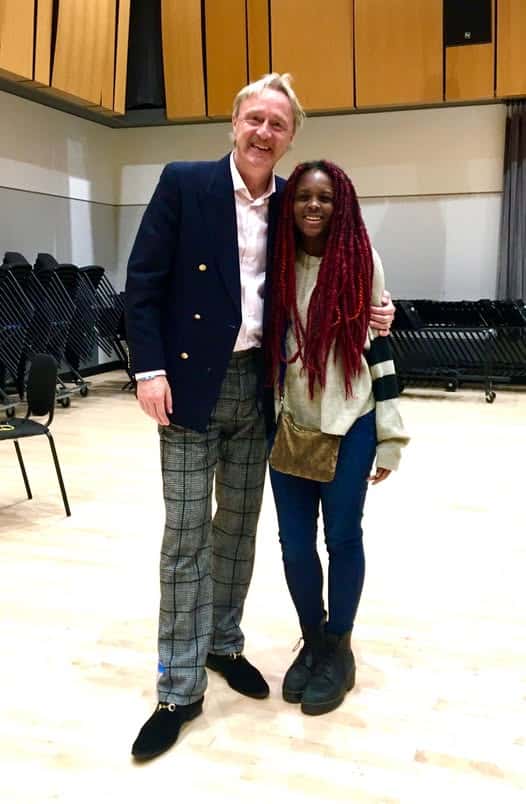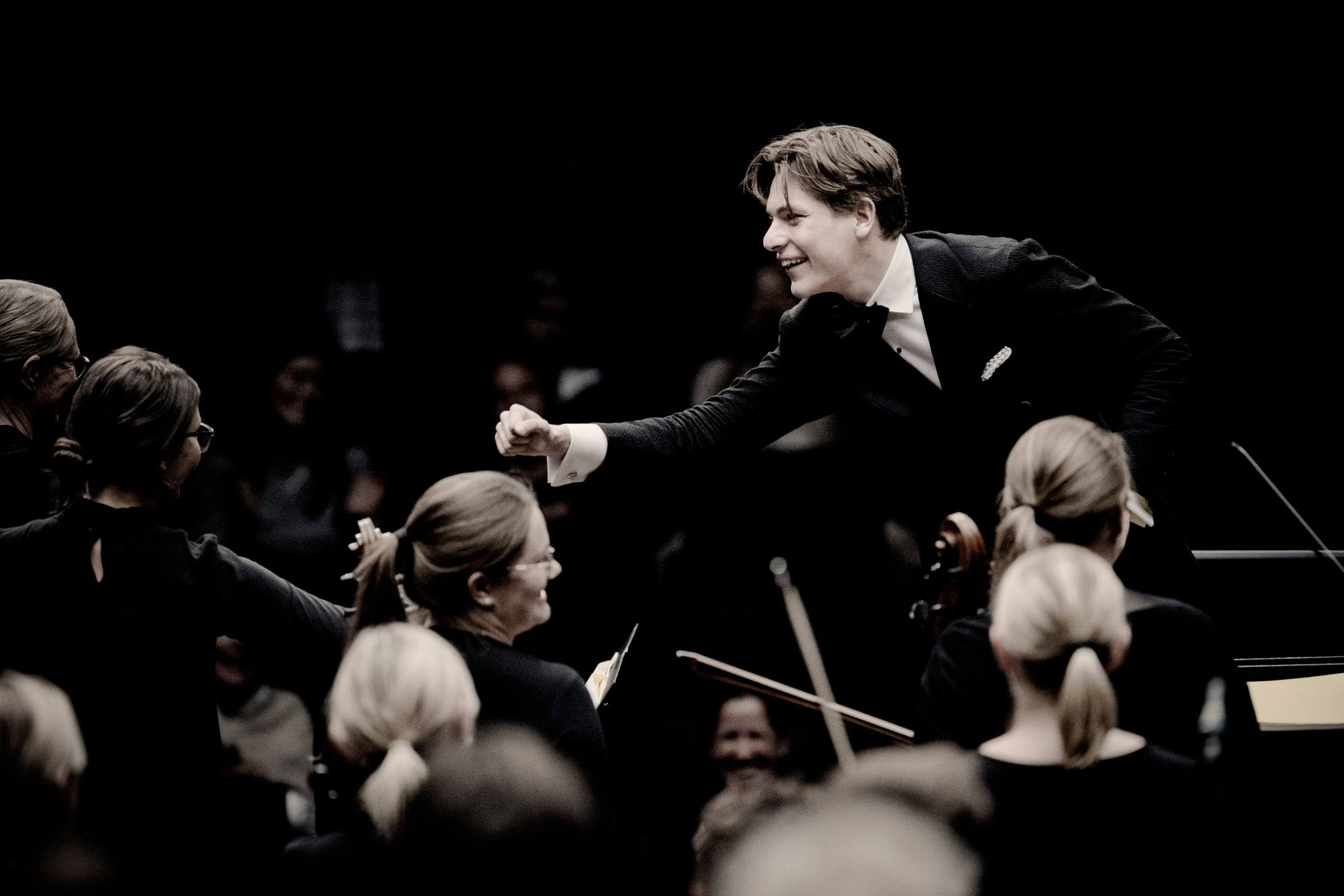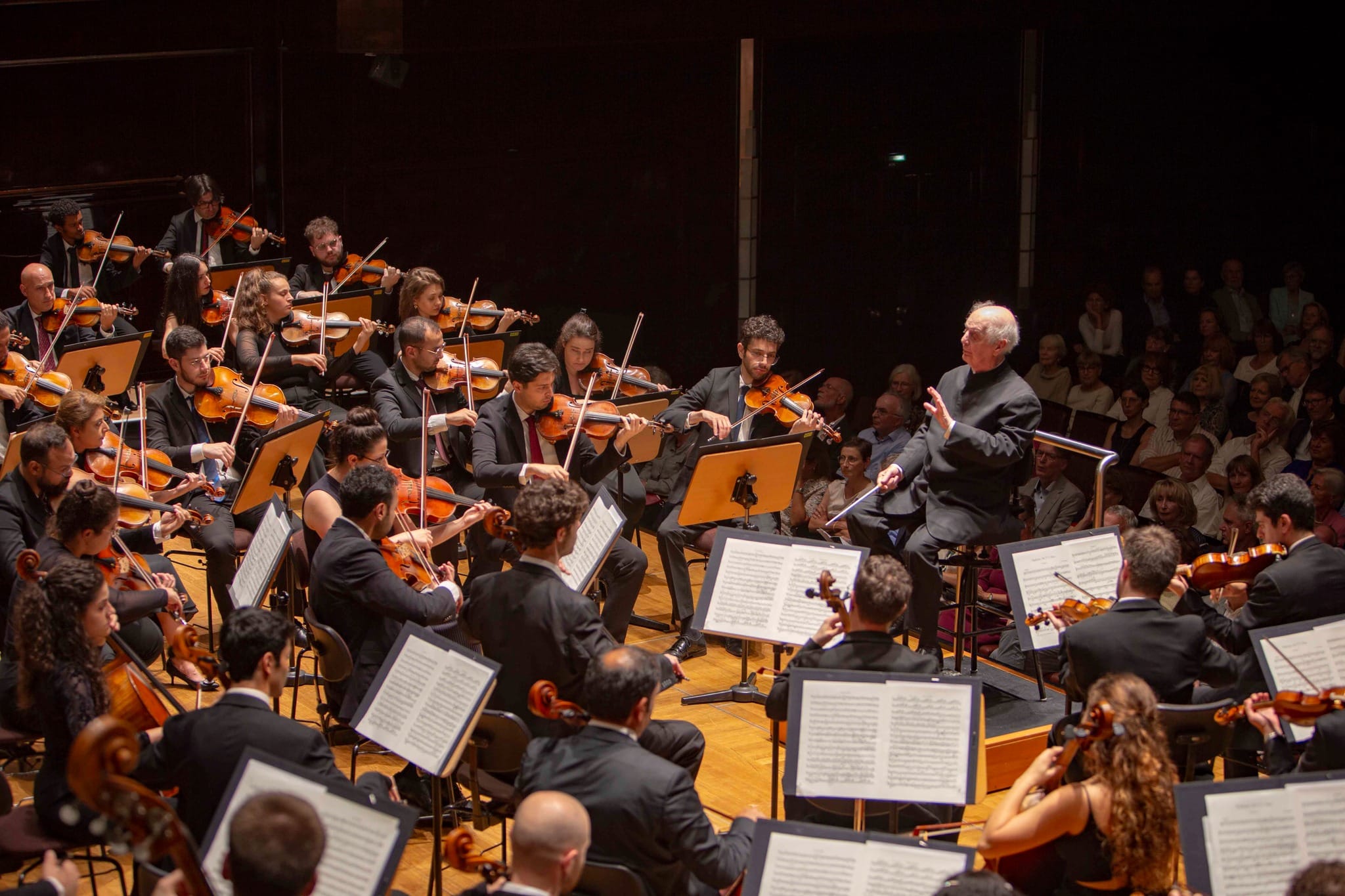Whatever became of the Great American Symphony?
mainFrom the Lebrecht Album of the Week:
Whatever became of the Great American Symphony? At one time it was discussed with as much cocktail-hour fervour as the Great American Novel and promoted by the best US orchestras. Leonard Bernstein at the New York Phil would not program a season without a symphony by a living American. But that was half a century ago.
Since the GAS has long gone off the boil, it’s almost a guilty pleasure to listen…
Read on here.

And here.





Is there one (a “great American symphony)?
There are at least several.
It’s really more of a rhetorical construct than an actual thing: the example that captures the essence of a country and its national character. Kind of like the idea of the Great Russian Novel (War and Peace? Brothers Karamazov?) or the Great French Novel (Les Misérables?), and so on. I don’t know if anybody but Americans talk about the Great This-or-that of their country.
Anyway, it used to be a question that people took into consideration, and put some effort into finding an answer for: here’s an American piece, it seems very good, let’s perform it and see how it does. And maybe the great piece hasn’t been written yet, so let’s try this new piece if it seems to have potential.
Keep in mind that the history books are full of critics (professional critics, or simply critical colleagues) who are remembered only because of their dismissal of work that is now part of the canon.
There are a good many. Start with Ives 4 and work your way from there!
I would like to see in concert a suite of the soundtrack of “On the waterfront” in concert like Chailly did sevral times with “La Strada”by Rota. It’s a real masterpiece and it’s a shame that Bernstein in the 50’s didn’t receive an Oscar for that.
Like the Great American Novel, which was surely going to come from some straight WASP (Fitzgerald, Hemingway etc) or Jewish male (Saul Bellow etc), the Great American Symphony disappeared when America discovered the multi-ethnic, -cultural, -sexual diversity that cannot possibly be contained a single Great American Anything that could encompass all of America.
In sum, there is no Great American Symphony inasmuch as there is no such thing as the Great European Symphony (despite the EU anthem of Ode to Joy): America, like Europe, is too diverse to be captured by any single work. (Sorry Beethoven, Germans may think otherwise notwithstanding.)
What, one wonders, is “multi-sexual diversity”? What is being sneered at via that phrase?
Methinks you know the answer to your question, since you seem to be the one doing the sneering.
An interesting if vexed question, but it proves the point that without advocate(s) possessing sufficient clout, zeal and drive to perform anything outside the ‘standard’, overplayed repertoire then anything ‘niche’, ‘obscure’, ‘different’, ‘difficult to digest’ that is without a proven audience is bound to struggle. But for those willing to listen, there are wonders out there in the neglected repertoire from any nation (of whichever discipline you prefer) that await discovery. So do yourself a favour – forget hearing yet another Beethoven cycle and try something new. This recording’s as good a place to start as any.
Simon Rattle when once asked about Lenny’s symphonic work said “He didn’t just wear his heart on his sleeve, he wore his entrails as well” and that, apart from synph #2 (Age of Anxiety) he found them a bit much – Jeremiah and Kaddish that is.
The Great American Symphony was already there, but thanks to sexism, the snobbery of orchestra boards and their mostly European music directors, and the inability of audiences to accept that an American could write a great symphony, the marvelous “Gaelic” Symphony by Mrs. H.H.A. Beach has for too long been overlooked. Did the likes of Bernstein ignore it because she was a she? Was it too old fashioned and not ugly enough? I’m glad to see that the Seattle Symphony is taking it up next season (although they call it “symphony no. 2” – that error was thanks to Kalmus). As a second, William Dawson’s “Negro Folk Symphony”.
Copland Third; William Schuman Third.
Gerard Schwarz told me David Diamond’s Second is no less fine, and GS knows them all for sure.
Composers do not seem to be drawn to the form of a traditional symphony with its four movement format, thematic development and architectural structure using motivic development.
Perhaps its the inevitable comparisons that will be drawn to the Masters.
It’s unfortunate as works in that format are what orchestras do best and what really defines the skills of a composer.
There are many symphonies that are written for symphonic bands but those are not heard in the traditional concert halls but on college campuses.
Not much fervour left for the Great American Novel, either…
They just couldn’t top that Harris 3rd. He said everything in 18 minutes that most couldn’t say in 60. Including that potboiler Copland 3 written six years later.
Michael Tilson Thomas has never performed the Harris 3rd and as far as I know, Leonard Slatkin has not recorded it. Wonder why!
I just listened to Harris 3rd. You are so right! Not convinced it’s better than Copland 3, but really a wonderful piece!
There was a time when, by coincidence, it seemed that symphonies numbered “three” were the top candidates for G.A.S. status: William Schuman, Aaron Copland, Roger Goeb, Roy Harris. Goeb and Harris seem to have fallen off the map but in my experience audiences still enjoy hearing the Copland and Schuman Thirds when they have the chance, and would likely enjoy Harris and Goeb, again if given the chance.
Indeed I think audiences would also enjoy hearing symphonies by Mennin, Diamond, Effinger, Hanson, Piston, and those of that era — and here’s that phrase again “if given the chance.”
Of them, only the Hanson “Romantic” seems to cling to the repertoire by its fingernails; maybe it is the influence of all those Interlochen alumni sitting in American symphonies who can play the Hanson Romantic without the orchestra having to schedule an extra and expensive rehearsal as they might have to do for the other American symphonies. But with the best will in the world I just cannot regard it as great, or even as Hanson’s best. But it is still better than some of the stuff Roy Harris churned out on commission.
Even the Ives No. 2 seems in danger of falling by the wayside, at least as far as I can tell (and thanks to the internet I do try to keep track of what American orchestras are programming). I am enough of a philistine to prefer it with Bernstein’s surprise ending.
I’d bet the Barber Symphony No. 1 is programmed as much as Mennin, Schuman, Piston, and Harris combined. Probably just slightly less often than Copland No. 3. It’s a marvelous piece. A prior generation of American critics, academics and composers should feel very guilty for sneering at Barber.
Based on number of performances I think Bernstein’s own Age of Anxiety has become pretty much standard repertoire, perhaps because there are more good pianists who enjoy the solo part than there are good singers who want to tackle the Jeremiah Symphony. I just can’t sit through the Kaddish due to the speaker (and squirm the same way through Copland’s Lincoln Portrait).
Here is my candidate for a (not “the” but “a”) Great American Symphony: John Adams’s Harmonielehre. It has size and scope, it somehow “sounds American” but without using cliché Americanisms. An orchestra that plays it knows it has really accomplished something; an audience that hears it knows it has really experienced something. I am so glad Edo de Waart programmed it with the Milwaukee Symphony before ending his tenure as Music Director. That was one concert I had to attend.
So at the end of the day, if a Great American Symphony has to be, at least in some respect, “great” but also performed, my list, and I suppose this is also my order of greatness:
Adams Harmonielehre
Bernstein Age of Anxiety
Barber No. 1
Copland No. 3
I enjoyed reading your post. You expressed my exact feelings about the Adams ‘Harmonielehre’. And why the Barber First isn’t in heavy rotation is one of the great mysteries to me. It’s a truly remarkable achievement.
The Hanson “Romantic” Symphony is programmed because it is familiar to audiences from the film “Alien.” Hanson received no credit for its use in the film, although it probably did more to popularize his music than any concert performance or recording.
I guess it takes an Englishman to remind us Yanks! It’s quite true: there are dozens and dozens of wonderful symphonies by American composer which never, or at least hardly, ever get played. Sessions, Barber, Hanson, Creston, Diamond, to name but a few. Gerard Schwarz did a great job of performing and recording many of these works with the Seattle Symphony.
I can’t comment on the development, progression and existence of the GAS in the USA.
Nevertheless, back here in the UK, I think that there are still GASs of many years standing that could do with an airing, more so than they are at present anyway.
It’s great that some orchestras have featured, and do feature, GASs such as Copland’s and Harris’s Thirds. However, other examples of the GAS? Surely we should be able to see UK ensembles programme Piston’s second or sixth meaningfully within a programme of more well-known repertoire? What about Copland’s Organ or Short symphony (the former went through a bit of resurgence in the early 2000s)? There’s Schuman’s third and Bernstein’s, Harbison’s and Sessions’s respective seconds. How about a bit of Howard Hanson or Christopher Rouse?
At various times, Music Directors of US origin have tried to bundle slabs of American music into the season programmes of UK orchestras. However, they’ve failed to gain any ground in this way, probably because they’ve approached matters as a “crusade for the unknown”. I think that there is probably an appetite out there for American music on concert platforms in the UK. However, let’s see it programmed more creatively and thoughtfully and, as well as the GAS, let’s hear more GAM (Great American Music), whether it be symphonies or not.
I can’t think of a better way of generating excitement at the beginning of a concert than with Schuman’s American Festival Overture or Corigliano’s Tournaments. Similarly, ending a concert with Barber’s Medea’s Meditation and Dance of Vengeance would be just as exciting as La Valse or Till Eulenspiegel?
With my own orchestra, I’ve programmed works by George Gershwin, Aaron Copland, Paul Creston, Walter Piston, Charles Ives, Wayne Barlow, Michael Daugherty, Samuel Barber, Leonard Bernstein and Lou Harrison. In each case, the pieces have sat within programmes that make sense contextually and, in the process, have gained an audience that they might not have enjoyed otherwise.
I’m now off to cleanse my pallet with to J S Bach!
“News that Kalmar is stepping down next season suggests they have run out of GAS.”
He’s been in Oregon for 20 years. That both may now be ready for other partners can be characterized more gracefully than “run out of GAS.”
If you want the Great American Symphony, though, look no further than Harold Shapero’s Symphony for Classical Orchestra (conductors out there, are you listening?).
Perhaps an even more pressing question would be, “Whatever became of the symphony?”
It may have been writtn long ago by John Knowles Paine as his firt, recorded by Mehtea for New World. Paine’s first symphony, rosutinely dismissed as derivative, has an adagio akin to Mahler’s “Adagietto”, is strongly constructed and traditional, yes, but memorable.
If you look around, you’ll find some recent works that qualify as “Great American Symphony” material. Here’s one, for instance. https://www.youtube.com/watch?v=E3iAuEGQ5Rg
I enthusiastically agree with you about Gallagher’s 2nd.
The American Music cemetery is overflowing with 20-century symphonies and orchestral works – those of David Diamond, William Schuman, Howard Hanson, Leon Kirchner, Walter Piston, Bernstein, Copland, Lukas Foss, David Del Tredici, Peter Menin, Alan Hovaness, Norman Dello Joio, Gunther Schiller, etc. All gone….
Far from being off the table, the Great American Symphony is still being debated here with vigor and pleasure, the reason being that we have so many exceptional works from which to choose.
Indeed. I’d throw the Ives 4th into the ring, in addition. Of course, talk of “the Great American” anything has its origins in the sense of high-cultural inferiority vis-a-vis European high culture. We could safely dispense with it entirely, at this point, and simply evaluate works on the basis of their individual merit and not their national origin.
It died a natural death ….you have no audience to support the GAS.So called classical music is not a part of the culture , at one time it was considered essential but time has shown it not necessary to present day life.It is used
mostly as window dressing to show others we are not
total barbarians and appreciate the finer things in life
or what is acknowledged as such.Every one espouses
new works provided it sounds like the old.
And why would that be?
It seems to me that the reason is, that ‘the old’ is just very good, and still very much alive in terms of performance. There is something in the language which comes across as superior to more recent works. Why would that be? It simply has to be acknowledged that all those old dead white males could do something much better than any contemporary young living coloured females. This is a very unpleasant truth, but maybe there’s something to be learned from it. Merely looking down upon this posthumous insistence blocks any understanding. Also, looking down on audiences which – time and again – prefer ‘the old’ over ‘the new’ is misunderstanding how audiences listen: not historically, like accompanying texts next to objects in a museum, but aesthetically and emotionally, and very subjectively so, as in love relationships.
Piston’s 7th symphony appeared in 1961. Perhaps you mean his 1st symphony in 1941.
You could try John Corigliano’s Symphonies 1 and 2. The first is highly recommended and I’m not familiar with the second.
Copland’s southernisms? Is the comment about Gould meant in a negative? What became of the American Symphony? What became of so many fine works from all over? They have been lost in marketing departments that perpetuate their myopic perspective. Marketing departments that hold the Knight Report as their Bible.
We now have the completed 9 symphonies by John T. Williams: Episodes 1-9.
What is to become of the great American symphony?
Here is the Piston:
https://www.youtube.com/watch?v=aXfIq2F_d9c
A kind of neo-classicism without the sparkling of Stravinsky or the intensity of Prokofiev. Very well-made, but – in spite of some beautiful lyrical passages in the adagio – a bit like the perfect suit for a funeral.
This is the Hanson:
https://www.youtube.com/watch?v=rbVB_wa2yFU
Expressive and brilliant piece, apart from some unnecessary hammering at places…. but well-made as the Piston but with so much more musical substance, and traditional in a free way. Norman is right, the music has something Scandinavian (lots of references to Sibelius), no wonder, strictly speaking he was a Swede:
https://en.wikipedia.org/wiki/Howard_Hanson
The idea of the GAS stems from a period when ‘the symphony’ was still seen as the most ambitious vehicle for a composer’s capacity to say something meaningful in abstract, ‘absolute’ music. Also, to get ‘American music’ on the rails of music history, ‘the Symphony’ seemed to be the best 1st class one-way ticket, under the pressures of the European traditions. But meanwhile, the destination seems to have evaporated.
But one does not need to write a symphony to be a composer of worth, and one often gets the impression that symphonies like the Piston and Hanson here, are the products rather of willpower than of true musical inspiration, like people dressing-up, with a heavy heart, for a reception where they know that they will be carefully watched.
I would nominate the Copeland Third and the William Schuman Third.
To bad Lebrecht can’t actually write.
??? Nonsense.
It’s tough to name a “GAS”, as you put it, Norman.
The Greatest American:
Piano Concerto: easy – Gershwin’s.
Sting Quartet: easy – Barber’s op. 11.
Piano Sonata: easy – Ives’ Concord.
Ballet Score: easy – Appalachian Spring (Copland again).
Musical: easy – Bernstein’s West Side Story.
But a “GAS”? There are too many of them! Harris 3, Piston 4, Hanson 3, to name a few – as well as the ones on the disc you review.
I believe you are shortchanging Gould. He wrote some brilliant music that many people know without knowing who wrote it, including 4 symphonies.
If you’d digged a bit deeper, you’d have seen that Copland Symphony 3 is generally considered to be the Great American Symphony. There’s not much doubt about that.
Not my area of expertise, but the trilogy of Copeland 3, Roy Harris Symphony 3 and William Schuman Symphony 3 are generally held to be the most important 3 works in US symphonic repertoire.
Your post, Norman, is a nice plug for Carlos Kalmar and the Oregon Symphony, but these are lesser US composers, IMHO. And Kalmar, an Uruguayan trained in Vienna with a contentious history with both US and European orchestra musicians, is not someone I’d look to as a definitive interpreter of US repertoire under any circumstances.
It’s a curious phenomenon, indeed, that South American conductors feel compelled to champion US repertoire. Perhaps if more US born & trained young maestri were given opportunities in their own country, the topic of the Great American Symphony could be explored and interpreted by someone with more cultural and historic understanding of the US than, say, Carlos Kalmar, or Gustavo Dudamel, or Carlos Miguel Prieto or Gian Carlo Guerrero, just to to name a few. Fine conductors, certainly, but why is it that more young US conductors are not discovering the Great American Symphony? Because they are not given opportunities in the US.
Let’s hope that the Oregon Symphony will have a look at US conductors when they replace Kalmar.
nonsense…..it’s not conductors but audience
You’re saying audiences are responsible for not programming US repertoire???
How are they even going to know what it is unless someone else (a conductor) programs it?
Your comment makes no sense. You are the one speaking nonsense.
ever hear of Ives your greatest composer
Ives was an insurance salesman. Figures that you’d take him for the greatest US composer.
Sorry, Ives was NOT a great composer. He was a funny, inventive experimentalist, living so much outside of any truly musical environment that he felt free to try-out things that sophisticated Europeans only dared to undertake after they first broke down their own cultural foundations.
http://johnborstlap.com/why-ives-is-not-a-great-composer/
I agree. Well said, John Borstlap.
“The Great American Symphony” is now a soundtrack by John Williams.
This review reads like it was written by someone who has a superficial grasp of American music and only the vaguest idea of the regional layout of the United States (southernisms?).
I only wish that composers of the caliber of Morton Gould were writing for Hollywood!
Piston won two Pulitzers, by the way.
As an orchestra player I have to comment that I think one reason a lot of US orch. repertoire is not familiar to us is the prohibitive rental costs. It makes it impossible to study excerpts from these symphonies & they can’t be easily included on audition lists so we can’t prepare them. It’s one reason why orchs struggle with Copland 3 and there aren’t many good recordings out there. Players don’t know it. You never get to see the part unless you are actually performing it with an orchestra.
I’m not sure what the solution is, but perhaps publishers should make individual parts & excerpts from major US works available to orch players without having to rent the whole expensive set. It shouldn’t be a crime to make and share a photocopied practice part when you do have a chance to play the piece. Because publishers are protecting this material so fiercely, players are not familiar with a lot of the repertoire.
Agreed. Copland 3 is hard. My orchestra played it at the beginning of this season. I was able to dig out the photocopy I made last time we played it (in 1993) and practice it over the summer, but our contract only requires that parts be made available two weeks before the first rehearsal, and we had 3 other programs to perform during those two weeks. So it was, um, pretty special.
A program of comparable difficulty — say, Don Juan, Till Eulenspiegel, and the Bartok Concerto for Orchestra — would have been a lot easier, because of the familiarity factor.
I have to give our management kudos for programming the piece and committing to perform an American masterpiece (and to the expense); but the musicians kind of felt that we weren’t able to do our best work due to the short preparation time, thanks to the copyright protections that prevented us from getting the music early enough (or learning it in school for auditions — goodness knows it wouldn’t be out of place on any audition list).
Thanks for seconding my opinion, Bruce! Exact same thing just happened to me on Copland 3. The complication, which I’m sure you discovered, is that that Copland 3 was revised in 2014, and the new parts are layed out differently, some sections re-metered and a previously omitted section put back in. So I had to learn it again off of the new part.
It really is audition worthy material for quite a few instruments. I had no qualms about copying my part & all the parts in my section, as well as the score. The copyright Nazis at Boosey and Hawkes may strike me dead.
There’s a study score available to purchase, but it’s like $100 and it doesn’t indicate which edition it is. I feel that publishers have very little regard for the musicians who actually play these symphonies. They should be listening to us, addressing our concerns and making these parts available for preparation.They’re only interested in generating rental income. Boo.
A very good idea.
There are more barriers to performing contemporary works, and another one is the royalty question. It would be better if composers would live off something else than royalties, and if publishers would be subsidised for their publishing new pieces so that rentals can be very low. Given the often awful quality of new music, it is already hard enough to get something new programmed; when on top of this, rentals are expensive, plus royalties, plus the impossibility for players to work on excerpts, so that expensive rehearsel time has to be planned, new music is built-in with high walls on all sides. Orchestras take a hughe risk with programming 20C works or newer pieces, and when they stick-out their neck, it should not also cost them more than a usual repertoire piece.
For me, the greatest American symphonic music is Bernard Herrmann’s soundtrack to Brian DePalma’s “Obsession.”
Some may accuse the soundtrack of being pure “schmaltz” but then again, it is no more schmaltzy than much of Rachmaninoff’s work.
O dear….
On further reflection I think the great American symphony is Dvorak’s “New Word”, full of “American” sounds, moods and melodies brilliantly scored and excitingm but its best recordings are Viennese.
Hi Edgar,
I also love the “New World”, but the subject here is symphonies written by American composers.
BTW, my favorite “New Worlds” are Reiner/Chicago and Talich and Ancerl, both with the Czech PO. Kertesz and Karajan made very nice recordings with the VPO. The best? A matter of taste…. All are marvelous!
(I have a Bruno Walter pre-war or WWII-era recording, but I can’t at the moment lay my hands on it. Too many boxes in too tall stacks. I remember it as being excellent.)
Barber 1
Bernstein 1
Copland 2 and 3
Creston 3
Diamond 3
Harris 3
Hanson 1, 2, 4
Piston 2 and 4
Schuman 3, 5, 8
Still 1 and 2
— the problem here is that none of these men could sustain a full CYCLE of masterpiece-symphonies, as opposed to their European counterparts….which makes them hard to market with the public. Such great music, and such a loss. Perhaps Barber was on to something, when he achieved perfection in that first “Symphony in One Movement”, then moved on. Of the living voices, there’s still hope, and more diversity.
I don’t think any of their cycles have been heard nearly enough to make such a sweeping judgment. let’s give them one hundred or more years of nearly constant exposure and then pronounce authoritatively.
Just a comment on the political correctness of the term “Great American Symph”:
“American” is a term that slides by without question or confusion in Britain and the US, but in Latin America, probably Canada and most certainly in Germany, where for some reason Germans seem intent on correcting any US citizen who tries to identify themselves as “American”, it is a misnomer.
South Americans are always quick to point our they they are also Americans. They make a VERY big deal out of this. It’s always a great relief to travel in Britain where no one questions you if you say you’re “American” which is a lot easier to say than “from the US”. I have even had someone question me as to “which” United States, because Mexico is also called the “United States of Mexico”.
So when you’re speaking of the “Great American Symphony” in order to appease our Latin American friends, we should either call it the “Great US Symphony” or include the great symphonists from ALL parts of America. Chavez, Ginastera, Revueltas come to mind. There are many more, and probably some very fine Canadian symphonists as well.
This is not nit picking. The term “American” is a HUGE bone of contention for South and Latin Americans. I have been corrected and chided on this point ad nauseum. Any US citizen who’s spent time there will understand this.
You certainly have a fair point; to append my early posting I think audiences would also greatly enjoy hearing Carlos Chávez’s Sinfonía India if given the chance. I myself have not heard his other symphonies – my fault.
There is the 2nd symphony of George Templeton Strong, of which a beautiful adagio is on the internet:
https://www.youtube.com/watch?v=UEhLqWEF_C8
It is Wagnerian/Brucknerian music, and thus very European, not much ‘America’ in it, but so what?
https://en.wikipedia.org/wiki/George_Templeton_Strong_(composer)
Copland’s Third, it we had to pick just one.
I can’t think of a more compelling candidate than William Schuman’s 8th, but it will never be popular.